Jay Leno's Garage
The first thing a visitor lucky enough to be invited into the private garage is confronted with is a row of beautifully restored, road-ready, vintage Stanley Steamer automobiles. Along the adjacent wall are several mammoth, 19th- and 20th-century steam engines which, like everything here I am to discover, are all in perfect running order and cranked up periodically simply for the enjoyment of hearing them run and to watch the giant flywheels turn.
At the multiple workstations, vintage automobiles and motorcycles are in various stages of restoration. Among the shelves of fenders, pistons, crankshafts and wheels are newly arrived shipping crates from all over the world, no doubt containing difficult to find pieces that will facilitate the resurrection of some of history’s motorized treasures.
Everything the eyes settle on intrigues, from the bikes and cars, to the wall art, to the array of machines and tools the full-time staff of seven utilize to breathe life back into these rolling gems. And it’s all remarkably clean. All I could muster upon entering the somewhat sanctified building was an appreciative sigh and a soft, “Wow, this is great.” That’s when the owner of this gearhead’s dream, American late night talk show host, Jay Leno, turned to me and said, “Jeff, this is just the shop.”
Leno, the comedian who helms NBC’s immensely popular Tonight Show, proceeded to lead me across the parking lot and into an adjacent building, opening the door to 100,000 square feet (about the size of a Tesco Store) of automotive and motorcycle splendour. For anyone in possession of even the slightest sentimentality or appreciation for motorcycles and automobiles, the contents of the place will almost certainly–either figuratively or perhaps literally–bring you to tears.
Under the lights, glistening in all their brilliant glory, are about eighty motorcycles that represent an entertaining collage of stirring two-wheel viscera. From the 1976 Hercules Wankel 2000, through a collection of pristine Vincents and Brough Superiors, to the 1967 Munch Mammoth, Leno’s collection is extremely eclectic. “I resisted for years calling it a collection,” Leno says, “but I guess it is a collection.” One of the truly amazing aspects of the collection is that everything runs and is taken out regularly. Leno is quick to explain, “What’s the fun of it if you can’t drive it?” Adding, “Everything has to work, including the clock.”
Leno definitely has a fondness for Vincents, as evidenced by several obscenely pristine Black Shadows and a very rare Vincent Black Knight occupying prime floor space. The comedian says that the Vincents were a legendary bike when he was a kid, and the impressive machines obviously made an indelible impact on the young Leno. He also likes the Brough Superiors, with a perfectly aligned row of the iconic machines backed up against one wall of the garage. With regard to the motorcycles made famous by T.E. Lawrence, Leno says, “They were kind of an anachronism, even in their time,” adding, “The best looking gas tank in the history of motorcycles.”
Spread out around the enormous garage there’s a 1988 Ducati 750 Paso Limited, a 1975 Suzuki RE 5 Rotary, a new Buell, a Harley Dresser, a Ninja ZX-14, as well as the infamous Y2K jet-powered bike. Two restored 1958 BSA Gold Stars share space with a 1934 Norton ES2, and in the adjacent row, a 1933 in-line 4-cylinder Indian sits next to a military green sidecar. Several motorized bicycles are overshadowed by two MV Agustas; one new, one old. A beautifully restored racing modified Honda 305 with the original Honda wing decal on the tank shares the floor with a Ducati Mike Hailwood Replica.
Like so many teenagers that fell in love with the Triumph brand, Leno fondly recalls, “Triumph Bonnevilles had a sticker on the tank that said, ‘For the expert rider,’ (and) being 16 and not having a license, of course I qualified.” Several “Bonnies” and a sexy 1953 Thunderbird hold court next to a BSA Rocket in close proximity to a line of untouched vintage machines waiting their turn in the machine shop for a thorough refurbishing.
There is certainly a gentlemanly favouritism toward the grand old marques. “I like bikes with a sense of theatre, a sense of ritual,” Leno says fondly, referring to the involved, often delicate process of getting some of the older, temperamental machines to kick over. Between tickling the carb, applying the right amount of throttle, anticipating kicking it through, just getting some of the bikes started is rewarding, let alone riding them.
What Leno looks for, what he most prefers, are “motorcycles that were ahead of their time, in their time.” Certainly filling that mandate, and perhaps the rarest motorcycle in the garage, is a 1923 Megola Sport Racer. The machine has its radial engine mounted inside the spokes of the front wheel, with the crankshaft mounted hard to the fork so that the engine rotates with the wheel. These bikes were popular grass-track racers in their time, with the gyroscopic effect of the rotating engine mass inside the front wheel actually aiding the rider with its natural tendency to right itself.
Leno likes machines with story behind them, like the time a man rang him up out of the blue and said, “I’m 92 and getting a divorce, I need to sell my damn bike.” The unintentionally humorous call resulted in the purchase of the man’s 1931 Henderson KJ, imbued with the often repeated, colourful back story.
One memory that Leno recalls with a hint of forlornness–obviously pondering the fate of the coveted machines. “(In) 1970, there was a guy in our town, a place called Merrymack Motors, who sold rebuilt Vincent Black Shadows with a one-year guarantee for $1,000. Went out of business – couldn’t give the things away.”
“The main difference I see between modern bikes and old bikes,” Leno muses, “is, in the old days you could earn your horsepower. You’d buy the bike, then ride for a few months, then put the twin carb set-up on it, get another couple of horsepower, then drive for a few months, and then might do a cam or do some head work – you would learn, sort of grow with the machine. It’s not really possible now, bikes come with 160 horsepower.”
Enshrined within these walls is an impressive collection of rolling art that quite accurately reflects an individual’s truly impassioned love affair with motorized vehicles. Jay Leno grew up in humble surroundings in the northeast state of Massachusetts. Like most boys he had an interest in motorcycles that was whetted by a ride on a mini-bike when he was 11. He remembers his mother screaming as he tore off across the open plains, thus starting a lifelong hobby.
Like most adolescent boys, his outside interest spilled over into school time, sitting in math class reading Cycle magazine strategically hidden under his math book, ogling the beautiful machines that graced the pages. “If you grew up in a town where everyone’s dad drove a four-door Galaxy,” Leno recalls, “you just didn’t see these kinds of exotic machines.”
Working at a McDonald’s while in High School, it was suggested Leno enter a local talent contest and tell jokes, since he was always cracking everybody up. He ended up winning, quickly ascertaining that making people laugh was a lot more fun than working at McDonald’s, and acquiring his first notions of a possible career in comedy. A couple of years later, while in college, Leno purchased his first motorcycle: a second-hand 1967 Honda CB350 from a Harley dealership. In a classic first bike experience, with no training and no helmet, Leno rode the bike all the way back to his college dorm in Boston, getting completely soaked through in a freezing rain. At one point when he went to look over his shoulder, the wind whipped his prescription glasses off and smashed them across the highway. The rest of the ride had him trying to decipher objects through squinted eyes, being pelted by rain.
Moving to California in the early ’70s, Leno was without a bike. He remembers pining for a Honda Four but didn’t have any money. In the years to come he built a career in stand-up comedy that eventually afforded him the opportunity to buy a brand new Honda CBX in 1979. Leno ended up crashing the motorcycle, replacing it with a 1981 model when the insurance money came through. Leno still owns the bike, joking that it’s hard to believe a machine he bought brand new now appears on the cover of vintage bike magazines.
What’s refreshing about Leno is that he is a true enthusiast. Unlike many celebrities that profess a love for motorcycles and cars once their bank account allows, Leno possesses a true, organic, life-long fascination for all things mechanical. He jokes that he “Likes anything that rolls, explodes, or makes noise.”
In truth Leno greatly respects and enjoys the intricacies and mechanical mysteries of machines. If you’re going to get into a bull session with Jay about anything motorized, you’d better have your mental chops in order. He is a virtual encyclopaedia about the workings and history of most anything that has a crankshaft or an axle, rattling off details of a machine’s history, design elements and performance specs, right down to the successes, failures, missteps and glories of the companies that gave birth to them.
Leno started the garage in 1991, when after years of hard work his burgeoning career rewarded him with the financial means to make it happen. What he and his team of talented technicians have created is more of a museum than merely a devoted hobbyist’s garage. Aside from the extensive array of motorcycles and cars, great attention has been given to the artwork that adorns the walls. Reproduced ads from vintage magazines and work by famed autosports artist of the ’20s and ’30s, Gordon Crosby, have been enlarged to decorate the environment in a warm and tasteful homage to yesterday.
A visitor could easily spend the day just perusing the framed newspaper clips of old racing news, pictures of racing legends, old manufacturer signage, and the accolades Leno has acquired during the span of his career, from his charitable endeavours to personal letters from Presidents. Every available shelf and countertop holds antique toys, models, and various nick-knacks, including several of Rollie Free’s land-speed record trophies.
Where Leno finds the free time to work on his cars and bikes is a mystery. In addition to his workweek schedule of 14-hour days preparing each evening’s taping of The Tonight Show, Leno is usually booked into a club for stand-up gigs on Friday and Saturday nights in Las Vegas, Reno, or Atlantic City. If that weren’t enough, he writes a regular column for Popular Mechanics. When he isn’t working on humor you can generally find him in his signature jeans and blue work shirt – his preferred wardrobe over the tailored suits he seems to begrudgingly slip into each night to tape his show – fiddling with or driving one of the vehicles from the garage.
On the four-wheel side of things, the 100 automobiles that comprise the collection are a metallurgical smorgasbord encompassing everything from a 1912 Stanley Steamer to a rare 1964 Studebaker Avanti. There are early electric vehicles, American muscle cars from the ’70s, rare European sports cars, strange Eastern-bloc contraptions, and pristine examples of Detroit iron reflecting America’s golden age of winged and flared beauty.
Qualifying for that last group, the car with perhaps the most personal and sentimental story is a silver and black 1955 Buick Roadmaster. Leno, arriving in Los Angeles in the early ’70s with dreams of pursuing a career as a funny man, found the car in the Penny Saver (a local newspaper with classified ads) and purchased it for $350. The aspiring comedian actually lived in the car for a while as he drummed up stand-up work, the gigantic back seat big enough to “Hold everything I owned” at that point in his life. But, eventually, as Leno explains, “A prettier car came along.” The Buick was relegated to the yard at the home of his newly acquired mother-in-law where it sat for 17 years before being brought back to life with a full restoration. The car now sits in the garage as a reminder of the early, lean times.
One quickly gets the impression that if Leno weren’t an entertainer he would slip into the automotive and/or motorcycle realm as a professional with the same aplomb that he elicits laughs from an audience.
When asked what he would be doing if he weren’t a comedian, Leno responds, “I’d probably be in car sales,” adding, “I’m too ham-fisted to be a mechanic.” As for what plans he has for the garage in the future, Leno shrugs nonchalantly, “Whatever happens, happens.”
http://www.jaylenosgarage.com/
The Rock Store
There is an old stone house on Mulholland Highway in the hills of Southern California that has been a legendary biker hangout ever since screen legend Steve McQueen first rode up the mountain from his Malibu home on a Sunday to have a beer. Public sightings of McQueen hanging out at the funky little stone grocery store gradually led to increased traffic. The reclusive movie star eventually stopped coming, but the Rock Store’s reputation as a biker’s hangout grew.
Throughout the hedonistic biker counter-culture of the ’60s and ’70s, the Rock Store was a regular destination for chopper-mounted bad boys. More often than not, rival gangs like the Hell’s Angels and Satan’s Slaves would descend on the place. Naturally, with that much conflicting testosterone rolling in to share the same piece of real estate, trouble usually ensued. Not that long ago, unless you were a heavily-tattooed biker with dental work periodically adjusted by fists, chances are you wouldn’t feel safe wading through the parking lot of chopped Harleys and leather-clad road warriors. By contrast, today the Rock Store is a much friendlier destination. Quite often passing tourists will stop to take photos of the eclectic gathering of machines and riders.
The Rock Store has been immortalized in numerous films, music videos, and commercials over the years. If you live in Southern California and ride a motorcycle, circumstance will eventually lead you to the Store. Over the years the demarcation line that once existed, segregating the Harleys, big cruisers and custom choppers from the sportier bikes, has vanished. Situated among some of California’s best motorcycling roads and given the famously mild winters and sunny summers ensures year-round fun. Of course, like flies to, well, you know what, California’s finest, the Highway Patrol, know that Saturdays and Sundays will fill out their quotas for citations, thus perpetuating the antagonism that exists between velocity seekers and the law. The atmosphere of the Rock Store traditionally encompasses the entire realm of two-wheel enthusiasts, from sportbikes, cruisers, customs, the touring crowd, supermoto, vintage, stunters, and drag racers. Walking through the overflowing parking lot each Sunday afternoon is akin to attending a motorcycle show.
Jay Leno has been a regular fixture at the Rock Store since 1979, when he bought his Honda CBX. Since then he’s become a kind of main attraction on Sundays, traditionally showing up on one of the rare or unusual bikes from the garage.
“I have the kind of machinery that people aren’t amazed that I got there quickly,” he says with a smile, “They’re amazed that I got there at all.” Leno adds, “When you drive a ’31 Henderson (up to the Rock Store) you feel like you’ve accomplished something.”
Due the close proximity to Malibu and Tinseltown, on any given Sunday you might catch a glimpse of a movie mogul, rock star, supermodel or perhaps a legendary racer. Doug Polen lives nearby and often puts in a visit. As he’s done for years, whenever Arnold Schwarzenegger – California’s Governor and former Terminator – is in town, he occasionally shows up on his Harley for an early morning breakfast at the Store. However, in contrast to his acting years, when he was accompanied by a posse of film cronies, he’s now escorted by a horde of Secret Service.
All in all, the Rock Store is a must visit for a motorcycle enthusiast when they’re in Southern California. In fact, many motorcycle enthusiasts/tourists I’ve spoken with made the trip from across the pond specifically to visit the legendary hangout, tying on a trip to Las Vegas or San Francisco as an afterthought.
The latest acquisition
The newest motorcycle to roll into Leno’s garage is a custom-built, S&S Cycle V-Twin-powered muscle bike, which Exxon Mobil 1 commissioned specifically as a one-off custom for Leno in honour of their long association with the comedian and motorcycle enthusiast. The bike is laden with the company’s new proprietary X-Wedge powerplant. The engine is a new generation, 117 cubic-inch air-cooled, pushrod V-Twin engine designed for performance while meeting progressively more stringent emission standards.
The machine exudes an interesting mix of personas, marrying the increasingly popular muscle bike platform with the feel of an American flat tracker. Wide bars render an upright seating position, with forward-mounted pegs reflecting more of a cruiser realm. A custom 2-into-1-into-2 exhaust system funnels into Arrow slip-ons for a throaty exhaust note.
The custom tubular frame has a rake of 28 degrees and a wheelbase of 63.2 inches, putting the big American V-Twin into the realm of sportbike as opposed to cruiser. Brembo, the gold standard of binders, grace the machine with dual rotors up front for plenty of stopping power. Ohlins forks on the front end are all business; an old-school, twin shock arrangement (also Ohlins) handles the rear. Beautiful, lightweight, gold-anodized Performance Machine wheels lend a sophisticated, sporty look to the S&S bike.
The black with pearl white paint scheme celebrates S&S Cycles 50th Anniversary. Leno says the bike is incredibly smooth, with the V-Twin motor surprisingly devoid of vibration–often the bane of the big Twins. The custom Exxon Mobil 1, 50th Anniversary S&S Cycle one-off has taken its place in the garage among some of motorcycling’s most revered machines.
More by Jeff Buchanan



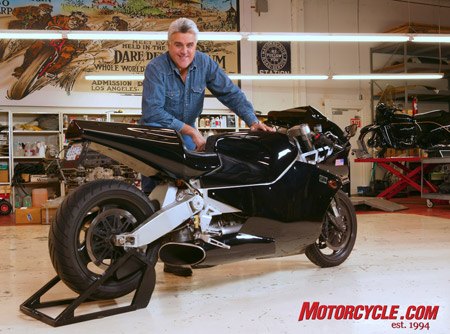















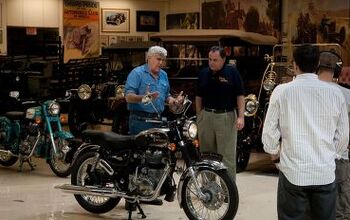
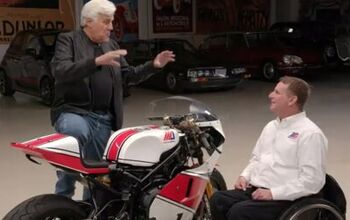
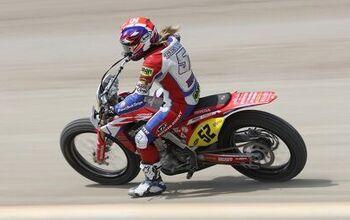

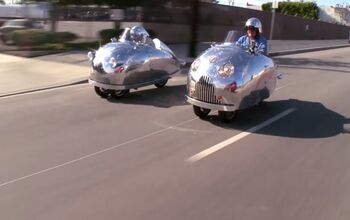


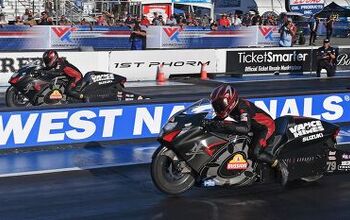










Comments
Join the conversation